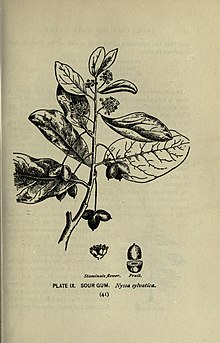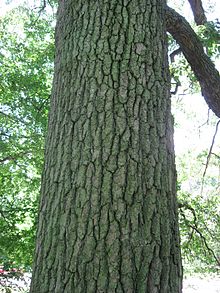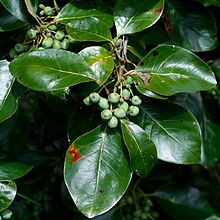Black tupelo tree
| Black tupelo tree | ||||||||||||
|---|---|---|---|---|---|---|---|---|---|---|---|---|

Black Tupelo Tree ( Nyssa sylvatica ) |
||||||||||||
| Systematics | ||||||||||||
|
||||||||||||
| Scientific name | ||||||||||||
| Nyssa sylvatica | ||||||||||||
| Marshall |
The black tupelo tree ( Nyssa sylvatica ) is a species of the tupelo trees ( Nyssa ) within the dogwood family (Cornaceae). It is common in eastern North America and occurs from southern Ontario to central Florida and eastern Texas as well as eastern Mexico .
description
Vegetative characteristics
Nyssa sylvatica grows as a medium-sized, deciduous and slow-growing tree with heights of 20 to 25, rarely up to 35 meters and trunk diameters of 50 to 100, rarely up to 170 centimeters. The trees usually have a straight trunk, from which the branches protrude at approximately right angles. The bark is reddish-brown on young twigs, but the color is covered by a grayish skin, later it is dark gray and scaly. The thick bark is furrowed and, in very old specimens, resembles the skin of alligators . The pith is chambered by greenish sections.
The simple foliage leaves , arranged alternately at the branch ends, are divided into a short petiole and leaf blade. The simple, pointed or round-pointed blade, mostly bald on top and sometimes slightly hairy on the underside, is elliptical or obovate, less often ovoid, with a length of 5 to 13 centimeters. The leaf margin is usually whole and often wavy, sometimes a few rough teeth appear in the front area. The top of the leaf is glossy. The foliage turns purple in autumn and finally bright scarlet. The stipules are missing.
Generative characteristics
Nyssa sylvatica are often dioeciously separated sexes ( dioecious ), so that male and female specimens exist and have to stand close together in order to set seeds. However, there are also many polygamous dioecious specimens that have hermaphroditic and unisexual flowers on one specimen. The male flowers sit in stalked, dense heads , umbels , the female appear in groups of two to three in stalked groups. The yellow-green, mostly five-fold flowers with a double flower envelope are very small. The sepals are only minimal teeth and the small petals fall off early. The approximately 10 stamens are protruding. The ovary , in a tubular and fleshy flower cup , is at the bottom with a thick stylus rolled up on top with a tapering stigma . There is one discus each. The female flowers may occasionally have staminodes.
The small, dark-bluish and ellipsoidal, olive-shaped and solitary drupes ( false fruit ) sit individually or up to three on a long, slender stem. The often "frosted", smooth fruits are about 10-12 millimeters long.
ecology
Nyssa sylvatica forms long, deep taproots, so that transplanting young specimens is difficult. Because of this, nursery cultivation is quite rare. The leaves of the seedlings and young specimens are extremely attractive to deer , so that large populations of them make it almost impossible for the trees to settle and adult specimens mostly stand alone.
The flowers are a rich source of nectar for bees .
The fruits, with a bland, oily, bitter to sour taste, but which are popular with small bird species, provide a valuable source of energy for some bird species, for example for migratory thrushes .
Nyssa sylvatica is an important source of food for many migratory bird species in autumn. Its early color change with the associated signaling effect for ripe fruits, which are available before those of many other plant species, is regarded as an attractor for birds. The fruits are particularly distinctive, dark blue and in groups of two or three. The acidic fruits are eager of birds like American Robin , dwarf Muse throttle , Gray-cheeked thrush , hermit thrush , wood thrush , Northern Cardinal , Mockingbird , Blue Jays , Red Bellied Woodpecker , Yellow-bellied Sapsucker , Flicker , Pileated Woodpecker , Eastern Phoebe , brown thrasher , Eastern Bluebird , Star , Scarlet Tanager , Cat thrush , cedar waxwing and American crow eaten, all migratory or stationary bird species from eastern North America that occur in the range of the tree.
The branches quickly deteriorate and the resulting caves offer excellent hiding places for croissants , raccoons , northern opossums and honey bees .
Its flowers are an important source of honey and the fruit an important source of food for birds . Cavities provide nesting and protection for bees and various mammal species . At up to 650 years or more, it is the longest-lived non- clonal flowering plant in eastern North America.
Occurrence
Nyssa sylvatica is found in eastern North America from southwest Maine and New York to the extreme south of Ontario , central Michigan , Illinois and central Missouri , south to southern Florida, eastern Texas and eastern Oklahoma . Nyssa sylvatica is also found locally in central and southern Mexico . There are localities for the southern part of the Canadian province of Ontario and the northeast to southeast and central US states Connecticut , Indiana , southwest Maine, southern Michigan, New Hampshire , New Jersey , New York , Ohio , Pennsylvania , Rhode Island , Vermont , West Virginia , eastern and southern Illinois, Missouri, Oklahoma, Wisconsin , Alabama , Arkansas , Delaware , Florida , Georgia , Kentucky , Louisiana , Maryland , Mississippi , North Carolina , South Carolina , Tennessee , Virginia and Texas and the Mexican states of Chiapas , Hidalgo , Puebla and Veracruz de Ignacio de la Llave .
Nyssa sylvatica grows in different hill countries and in the river plains. Lower slopes and terraces in the southeastern United States offer optimal development opportunities. Nyssa sylvatica comes in a variety of in its expanded distribution area upland and wetland - habitat before.
Nyssa sylvatica grows in a wide range of climatic conditions due to its extensive range. It can be found in the USA both in the river plains of the southern coastal plains and at altitudes of up to 900 meters in the southern Appalachians . Nyssa sylvatica thrives best on well-ventilated, lightly textured soils on the low "ribs" and higher plains of muddy alluvial lands. In the highlands, loam and clay loam on lower slopes and bays offer the best growing conditions.
Nyssa sylvatica occurs in 35 different forest types . On drier higher slopes and "ribs" it rarely grows to maturity .
Taxonomy
The first publication of Nyssa sylvatica was made in 1785 by Humphry Marshall . The specific epithet sylvatica stands for the forest habitat.
Common names and etymology
Common English names are Tupelo, Black gum, sour gum.
The common name Tupelo comes from the language of the Creek Indians and is composed of the words ito = "tree" and opilwa = "swamp"; it was in use until the middle of the 18th century.
While Nyssa sylvatica is often only called "Tupelo" in the English-speaking world, the more precise designation Black tupelo ("Black Tupelo") supports the differentiation from other species of the genus Nyssa , some of which have overlapping distribution areas such as water tupelo tree ( Nyssa aquatica ) and Marsh tupelo tree ( Nyssa biflora ). The name "Tupelo" is mainly used in the southern states , while Nyssa sylvatica northwards and in the Appalachians generally means Black gum or Sour gum , although no part of the plant is resinous ( English gum = "resin"). The latter two names are in contradiction to another tree species with a strongly overlapping distribution area, the American sweetgum tree ( Liquidambar styraciflua ; English Ssweet gum ), which produces an aromatic resin. Another name that is occasionally used in the northeastern United States is Pepperidge .
On Martha's Vineyard in Massachusetts , the kind of "Beetle Bung" is called, perhaps due to the use of a mallet called "Beetle", which for turning the plugs ( English Bung used in barrels).
use
cultivation
Nyssa sylvatica is planted as an ornamental plant in parks and large gardens, where it often acts as a solitary or shade provider. Nyssa sylvatica thrives best in sheltered, but not too densely planted areas, and forms a pyramidal outline when young; in old age it spreads. The trunk protrudes as a continuous shaft to the top of the tree, the branches sprout at right angles and are either horizontal or slightly sagging, so that they form a columnar or conical crown.
The branches are thin and numerous; they lie horizontally so that the appearance is similar to that of the European beech . Some of the plant specimens have a spectacular autumn color, with intense red to purple tones, which is very much appreciated in landscaping. It is the “most fiery” species within the “brilliant group”, which also includes maples , dogwoods , sassafras and sweetgum trees, as well as various Nyssa species.
In Great Britain , the cultivar 'Wisley Bonfire' received the Award of Garden Merit from the Royal Horticultural Society .
Honey production
Nyssa sylvatica is an important source of wild honey in many areas of its distribution area. Holes in the trees were previously used by beekeepers as a beehive .
Wood
The medium-weight, moderately resistant wood of the black tupelo tree is quite hard, cross-grained and difficult to split, especially after drying. From this mallets , rolls and tackles , wheel hubs and bowls were made. It is also processed into turntables, raw fibers, pulp and firewood. Web shuttles were also made from it. Due to its sufficient resistance and the very good " impregnability ", it was a preferred wood for the manufacture of railway sleepers. It is also well suited for use in factory floors, as well as for carving.
Individual evidence
- ↑ a b c d e f William B. Werthner: Some American Trees: An intimate study of native Ohio trees . The Macmillan Company, New York 1935, XXV, p. 344-348, 397 ( hathitrust.org ).
- ↑ Eastern OLDLIST, A database of old trees, Columbia University. Retrieved July 2, 2019 .
- ↑ a b Milo Coladonato: Nyssa sylvatica . In: Fire Effects Information System. US Department of Agriculture, Forest Service, Rocky Mountain Research Station, Fire Sciences Laboratory, 1992, accessed September 30, 2012 .
- ↑ a b c Nyssa sylvatica in the Germplasm Resources Information Network (GRIN), USDA , ARS , National Genetic Resources Program. National Germplasm Resources Laboratory, Beltsville, Maryland. Retrieved September 5, 2019.
- ↑ a b c Black Tupelo . US Forest Service , accessed August 25, 2020 .
- ↑ Tupelo, Black gum, sour gum - Nyssa sylvatica In: The Arboretum in Hørsholm - Plant Descriptions - Plant of the Month. University of Copenhagen , accessed May 15, 2018 .
- ↑ Erin McKean (Ed.): New Oxford American Dictionary . 2nd Edition. 2005.
- ^ William C. Paxton: Why Do They Call It a Gum Tree? Penn State Extension, 2014 ( March 4, 2016 memento on the Internet Archive ).
- ↑ Harriet L. Keeler : Our Native Trees and How to Identify Them . Charles Scribner's Sons, New York 1900.
- ↑ RHS Plant Finder - Nyssa sylvatica 'Wisley Bonfire'. Retrieved April 4, 2018 .
- ^ AGM Plants - Ornamental. (PDF) Royal Horticultural Society, July 2017, accessed April 13, 2018 .
- ↑ Ethel Eva Crane: The World History of Beekeeping and Honey Hunting . Routledge, 2013, ISBN 0-415-92467-7 , pp. 305 ( limited preview in Google Book Search).
- ^ Harry A. Alden: Hardwoods of North America. USDA, Forest Service, Technical Report 83, 1995, p. 78 ff.
- ^ David A. Webb, Geoffrey V. Webb: The Tie Guide . 2nd Edition. Railway Tie Association (RTA), 2016 ( rta.org [PDF; 6.4 MB ]).
Web links
- Nyssa sylvatica near Southeastern Flora (detail images).
- Common Trees of the North Carolina Piedmont at Ibiblio.
- Nyssa sylvatica at Oregon State Univ. (English).
- Black Tupelo at Illinois Wildflowers.
- Nyssa sylvatica on hort.net (English).
- Nyssa sylvatica at Plants Database, USDA Plants.




